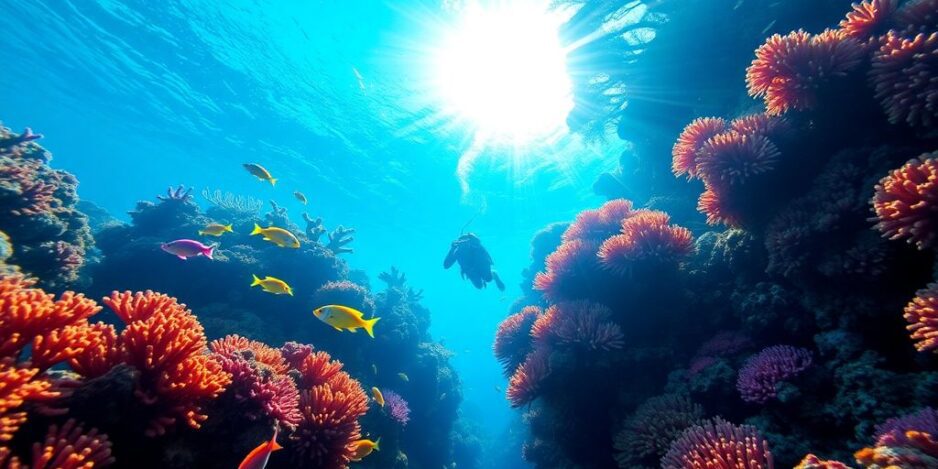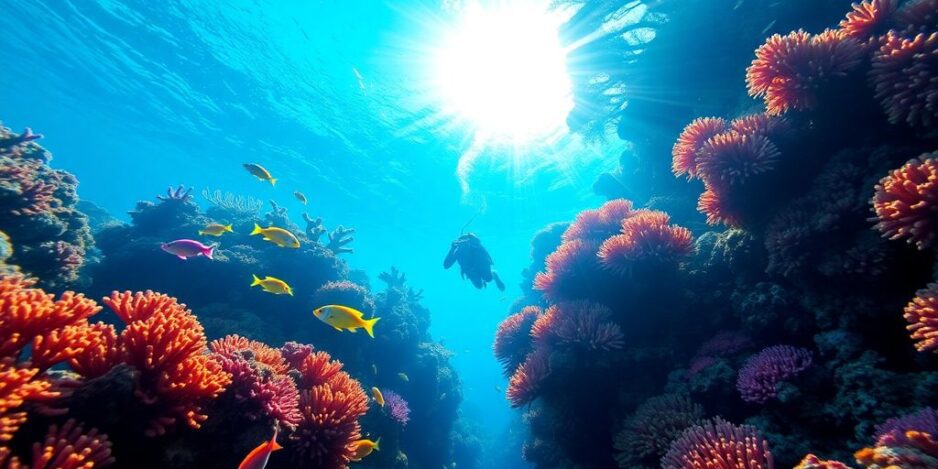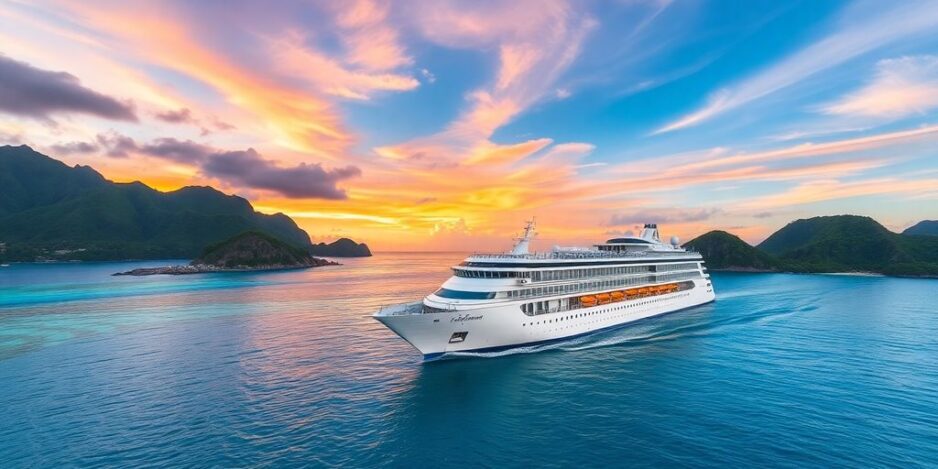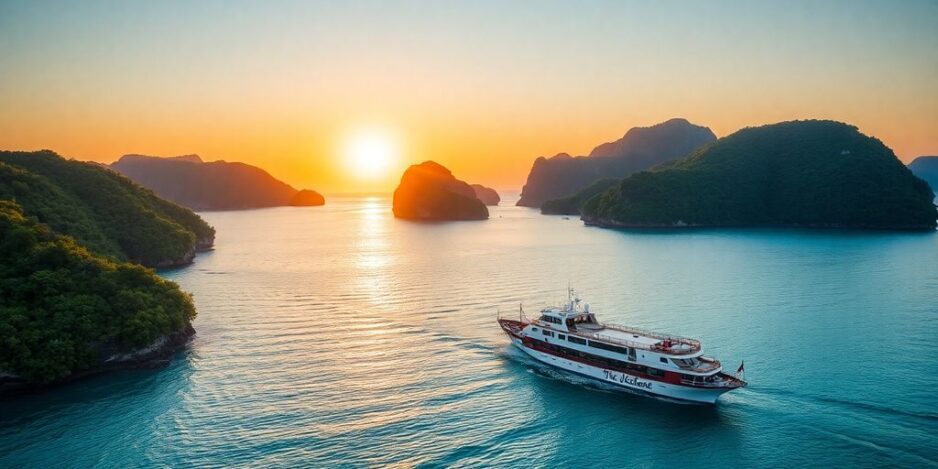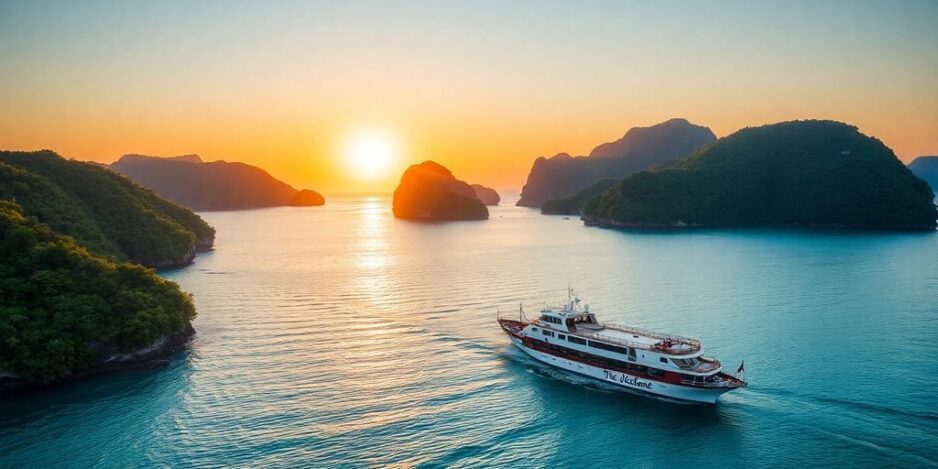If you’re dreaming of a trip where you can snorkel and dive in some of the world’s most stunning spots, a Paul Gauguin cruise might just be your ticket to paradise. From the vibrant reefs of Bora Bora to the hidden gems of Rangiroa, there’s no shortage of underwater adventures waiting for you. And let’s not forget about the unique marine life you’ll encounter along the way. It’s like stepping into a whole new world beneath the waves. So grab your gear, and let’s dive into the best snorkeling and diving spots on this unforgettable journey.
Key Takeaways
- Bora Bora offers incredible snorkeling and diving, with vibrant marine life and stunning lagoons.
- Moorea is a must-visit for its coral gardens and beginner-friendly diving spots.
- Rangiroa’s Blue Lagoon and Tiputa Pass are perfect for adventurous snorkelers and divers.
- Fakarava is known for its unique coral formations and diverse marine species.
- Tahiti has hidden snorkeling and diving spots that are worth exploring.
Exploring the Underwater Wonders of Bora Bora

Top Snorkeling Sites in Bora Bora
Bora Bora is a snorkeler’s paradise, boasting some of the clearest waters you’ll ever see. The Coral Gardens are a must-visit for anyone looking to explore vibrant marine life up close. You can expect to see colorful fish darting through the corals and maybe even spot a turtle or two. Another top spot is the Lagoonarium, where you can snorkel alongside stingrays and small sharks in a safe, enclosed area.
- Coral Gardens: Known for its stunning coral formations and diverse fish species.
- Lagoonarium: Offers a chance to swim with rays and sharks.
- Matira Beach: Perfect for beginners, with easy access to shallow waters.
Diving Adventures in Bora Bora’s Lagoon
Diving in Bora Bora’s lagoon is like entering another world. The calm, warm waters make it ideal for both beginners and experienced divers. You can dive at Anau, where manta rays gracefully glide by, or explore Tapu, famous for its shark encounters. For those seeking a thrill, diving at the White Valley offers a chance to see larger marine life like barracudas and even the occasional dolphin.
Marine Life You Can Encounter in Bora Bora
The marine life in Bora Bora is nothing short of spectacular. From vibrant corals to a variety of fish species, there’s always something to see. Keep an eye out for clownfish, parrotfish, and butterflyfish among the reefs. If you’re lucky, you might spot a majestic manta ray or a gentle sea turtle passing by.
Snorkeling and diving in Bora Bora offer a unique opportunity to connect with nature in a way that’s both thrilling and serene. The island’s underwater world is a treasure trove of wonders waiting to be discovered.
Discovering the Coral Gardens of Moorea
Best Snorkeling Locations in Moorea
Moorea is like a dream come true for snorkelers. The island’s crystal-clear waters reveal a vibrant underwater world that’s just waiting to be explored. Snorkeling in Moorea offers a chance to swim alongside colorful fish and see stunning coral formations up close. Some of the top spots include:
- Temae Beach: Known for its clear water and abundant marine life, it’s a favorite among both locals and visitors.
- Opunohu Bay: Offers a more secluded experience with a rich array of fish and coral.
- Tiahura Beach: Known for its shallow waters, making it ideal for beginners.
Diving Spots for Beginners in Moorea
For those new to diving, Moorea provides an inviting environment. The gentle currents and warm waters make it an excellent place to start your underwater journey. Some beginner-friendly diving spots include:
- The Garden of Roses: Famous for its unique coral formations.
- The Aquarium: Perfect for seeing a variety of marine species in a calm setting.
- Taotoi Pass: Offers easy access and is teeming with aquatic life.
Unique Marine Species in Moorea
In Moorea, you can encounter a variety of unique marine species that make snorkeling and diving truly special. Butterflyfish, parrotfish, and even the occasional sea turtle can be seen gliding through the water. Keep an eye out for the playful dolphins that often swim near the shore.
Moorea’s underwater world is a vibrant tapestry of life, offering a glimpse into the beauty and diversity of marine ecosystems. Whether you’re a seasoned diver or a first-time snorkeler, the island’s waters promise unforgettable experiences.
For those embarking on a 7-night journey aboard the m/s Paul Gauguin, Moorea offers ample time for exploration and discovery. With its stunning coral gardens and diverse marine life, it’s a highlight of any aquatic adventure.
Unveiling the Hidden Gems of Rangiroa
Snorkeling in the Blue Lagoon of Rangiroa
Rangiroa is like a dream for snorkelers. The Blue Lagoon is a must-see, with its crystal-clear waters that seem almost unreal. You can spot colorful fish darting around, and if you’re lucky, maybe even a friendly dolphin. It’s one of those places where the underwater world feels like a vibrant painting come to life.
Diving with Sharks in Rangiroa
For those who crave a bit more thrill, diving with sharks in Rangiroa is an experience you won’t forget. The adrenaline rush as you come face to face with these majestic creatures is something else. It’s not just about the sharks, though; the coral and other marine life make every dive unique.
Exploring the Tiputa Pass
The Tiputa Pass is famous for its strong currents and abundant marine life. Divers flock here to witness the stunning underwater biodiversity. It’s not uncommon to see manta rays gliding gracefully or schools of barracuda flashing by. The pass offers a mix of excitement and beauty that’s hard to match.
Rangiroa isn’t just a destination; it’s an adventure waiting to happen. With its stunning lagoon and diverse marine life, it’s a place that captures the heart of every visitor. Whether you’re snorkeling or diving, the experiences here are unforgettable.
For those looking to explore the beauty of Rangiroa, the m/s Paul Gauguin offers an unforgettable journey through Tahiti and the South Pacific. With luxurious amenities and breathtaking views, it’s the perfect way to experience this underwater paradise.
The Vibrant Reefs of Fakarava

Snorkeling in Fakarava’s South Pass
Fakarava’s South Pass is a must-visit for snorkeling enthusiasts. This spot is like nature’s aquarium, teeming with colorful fish and stunning coral formations. Snorkelers will be amazed by the sheer diversity of marine life here. From tiny clownfish darting between anemones to graceful manta rays gliding by, there’s something for everyone. It’s best to go with the tide, so check local guides for the best times.
Diving in the Garuae Pass
The Garuae Pass in Fakarava is famous for its thrilling diving experiences. Known as one of the largest passes in French Polynesia, it offers divers a chance to encounter large schools of fish, sharks, and sometimes even dolphins. Visibility here is usually excellent, making it easier to spot the diverse marine life. For those seeking an adrenaline rush, drift diving through the pass is highly recommended.
Coral Formations and Marine Life in Fakarava
The coral formations in Fakarava are nothing short of spectacular. These vibrant reefs are home to a wide array of marine species, making it a paradise for underwater photographers. When exploring these reefs, you’ll find everything from intricate coral patterns to the playful antics of reef fish.
Fakarava is not just a destination; it’s an experience that captivates the soul. Whether you’re diving or snorkeling, the vibrant marine life and stunning coral formations will leave you with memories to last a lifetime.
For those looking to explore further, Fakarava offers more than just underwater adventures. Its laid-back atmosphere and breathtaking scenery make it a perfect getaway for both thrill-seekers and those looking to unwind. Don’t miss the chance to explore the Fakarava Reef, a true snorkeling and diving paradise.
Tahiti’s Best Kept Snorkeling and Diving Secrets
Snorkeling Spots Near Papeete
Tahiti’s capital, Papeete, isn’t just about vibrant markets and cultural experiences. The waters nearby hold some of the island’s best-kept snorkeling secrets. Tahiti’s coral reefs are teeming with life, and you’ll find colorful fish darting among the corals just a short swim from the shore. Some of the top spots include:
- Lagon de la Plage de Toaroto: A great place for beginners with calm, shallow waters.
- Pointe Vénus: Known for its black sand beach and clear waters, it’s a favorite among locals and tourists alike.
- Plage Lafayette: Offers a more secluded experience with rich marine life.
Diving in Tahiti’s Clear Waters
Diving in Tahiti is like entering a new world. The clear waters here offer visibility that’s hard to beat. Dive sites range from shallow coral gardens to deeper spots with dramatic drop-offs. Some of the must-visit dive sites include:
- Aquarium: Perfect for beginners, it’s like swimming in a giant fish tank.
- La Vallée Blanche: Known for its encounters with reef sharks and stingrays.
- The Marado: A deep dive where you might spot larger marine life.
Tahiti’s diving spots are perfect for both diving enthusiasts and families seeking natural beauty and adventure.
Exploring the Marine Reserve of Tahiti
If you’re looking to see Tahiti’s marine life in its most pristine form, the island’s marine reserves are the places to be. These protected areas ensure that the marine ecosystem thrives, offering snorkelers and divers a glimpse into a world untouched by time.
- Papenoo: A marine reserve that promises an abundance of fish and coral.
- Faaa Lagoon: Offers a unique mix of marine species, thanks to its protected status.
- Teahupoo: Known for its big waves, but beneath the surface, it’s a tranquil haven for marine life.
Exploring these hidden gems of Tahiti is like opening a treasure chest of marine wonders. Each spot offers a unique experience, whether you’re gliding over a vibrant coral garden or diving into the deep blue. The island’s underwater world is as diverse and captivating as its landscapes above.
The Pristine Waters of Huahine

Top Snorkeling Beaches in Huahine
Huahine is like a hidden gem in the Pacific, offering some of the most untouched snorkeling spots you’ll ever see. The beaches here are just perfect for snorkeling, with clear waters that let you see everything. Some of the top spots to check out include Avea Beach, where you can float above colorful coral gardens, and Hana Iti Beach, known for its calm waters and vibrant fish. Don’t miss out on snorkeling at Fare Beach, where the underwater world is just waiting to be discovered.
- Avea Beach: Coral gardens and clear waters.
- Hana Iti Beach: Calm waters with vibrant marine life.
- Fare Beach: A diverse underwater ecosystem.
Diving Sites for Advanced Divers in Huahine
For those who love diving, Huahine offers some challenging spots that are totally worth it. The island’s outer reef is a great place to see larger marine creatures, and the currents here make it exciting for more seasoned divers. The "Canyon" is a popular spot where you can explore underwater valleys and swim alongside reef sharks. If you’re up for an adventure, try diving at the "Needles," where steep drop-offs and abundant sea life await.
- The Canyon: Underwater valleys with reef sharks.
- The Needles: Steep drop-offs teeming with sea life.
- Outer Reef: Ideal for spotting larger marine creatures.
Marine Biodiversity in Huahine
Huahine’s waters are home to a rich variety of marine life. From the colorful parrotfish to the elusive moray eels, the biodiversity here is truly stunning. You might even spot a sea turtle gliding gracefully through the water or a school of barracuda darting by. The coral reefs are alive with activity, providing a home for countless species of fish and other marine creatures.
Huahine’s underwater world is a vibrant tapestry of life, with each dive and snorkel revealing new wonders. Whether you’re a seasoned diver or just dipping your toes into the world of snorkeling, the island’s waters offer an unforgettable experience.
Exploring Huahine’s pristine waters is like stepping into a natural aquarium, where every moment is filled with awe and discovery. If you’re planning a trip, make sure to include this island on your itinerary for an unforgettable adventure. And if you’re on the 11-night journey aboard the m/s Paul Gauguin, you’ll get to experience this firsthand. Don’t miss the chance to explore the stunning beaches and rainforests of Huahine, a true paradise on Earth.
Raiatea’s Underwater Paradise
Snorkeling in Raiatea’s Coral Gardens
Raiatea, often overshadowed by its more famous neighbors, is a hidden gem for snorkelers. The coral gardens here are like nature’s kaleidoscope, bursting with colors and life. The calm waters make it perfect for beginners and seasoned snorkelers alike. When you dip beneath the surface, you’re greeted by a vibrant world of fish darting in and out of the corals. It’s like swimming in a living painting.
- Explore shallow reefs teeming with tropical fish.
- Encounter clownfish and parrotfish in their natural habitat.
- Discover hidden nooks filled with sea anemones and starfish.
Diving the Wrecks of Raiatea
For those who crave a bit more adventure, Raiatea offers some intriguing dive sites. One of the highlights is exploring the wrecks that lie beneath the waves. These sunken treasures are home to a variety of marine life, making each dive a unique experience. The thrill of uncovering these underwater relics is something every diver should experience.
- Dive into history with shipwrecks from a bygone era.
- Spot schools of barracudas weaving through the wreckage.
- Marvel at the coral formations that have claimed these structures.
Unique Aquatic Life in Raiatea
Raiatea’s waters are brimming with unique aquatic life. From the tiniest nudibranchs to majestic manta rays, the biodiversity is astounding. As you swim, you might even catch a glimpse of a sea turtle gliding gracefully by. Raiatea truly offers a window into the underwater world, where every dive or snorkel trip reveals something new.
Raiatea is a place where the underwater world feels just a bit closer to the surface. It’s not just about the sights, but the feeling of being part of something vast and beautiful.
For those looking to explore beyond the water, Raiatea and Tahaa offer rich cultural experiences and stunning landscapes, making them a must-visit on any Tahiti cruise. Whether you’re diving among the wrecks or snorkeling in the coral gardens, Raiatea’s underwater paradise is sure to leave a lasting impression.
Taha’a: The Vanilla Island’s Aquatic Treasures

Snorkeling in Taha’a’s Lagoon
Taha’a, also known as the "Vanilla Island," is a paradise for snorkeling enthusiasts. The island’s lagoon is a vibrant underwater wonderland, teeming with colorful coral gardens and a variety of marine life. Snorkelers can expect to see everything from clownfish to the occasional sea turtle gliding by. The calm, clear waters make it an ideal spot for beginners and seasoned snorkelers alike.
Diving Adventures Around Taha’a
For those who prefer diving, Taha’a offers some truly unforgettable experiences. The island’s dive sites are less crowded than others in the region, providing a more intimate encounter with the ocean’s depths. Divers can explore stunning coral formations and encounter diverse marine species. Visibility is often excellent, making it easier to spot the vibrant underwater life.
Exploring Taha’a’s Coral Reefs
Taha’a’s coral reefs are nothing short of spectacular. A boat tour around the island’s lagoon is a must for anyone looking to explore these natural wonders. Visitors can witness the intricate beauty of the reefs and the bustling marine life that calls them home. It’s a serene and captivating experience that showcases the island’s natural beauty.
Taha’a is a place where the rhythm of the ocean meets the gentle sway of vanilla-scented breezes. It’s an island that invites you to slow down, breathe deeply, and immerse yourself in the simple pleasures of life.
For those looking to dive deeper into the wonders of the South Pacific, discover the breathtaking diving spots of the Pitcairn Islands as well. Meanwhile, Taha’a remains a tranquil haven, offering a unique blend of natural beauty and cultural richness. Whether you’re exploring the underwater treasures or simply relaxing on its serene beaches, Taha’a is a destination that promises to enchant and inspire.
The Enchanting Waters of Tetiaroa
Snorkeling in Tetiaroa’s Lagoon
Tetiaroa is a paradise for snorkelers. With its crystal-clear lagoon, it’s a top spot for those wanting to explore vibrant coral reefs and colorful fish. The lagoon’s calm waters make it perfect for beginners and families. You might even spot a sea turtle or two gliding gracefully beneath the surface.
- The lagoon is home to a variety of tropical fish.
- Coral formations in Tetiaroa are both unique and stunning.
- Snorkeling here is best during the morning when the sun lights up the underwater world.
Diving in the Pristine Reefs of Tetiaroa
For those who prefer diving, Tetiaroa offers pristine reefs that are a diver’s dream. The underwater visibility is exceptional, providing a clear view of the diverse marine life that inhabits these waters. Experienced divers will appreciate the depth and variety of the dive sites available.
- Dive among vibrant coral gardens teeming with life.
- Encounter schools of colorful fish and other marine creatures.
- Explore the underwater caves and hidden spots that Tetiaroa has to offer.
Marine Conservation Efforts in Tetiaroa
Tetiaroa isn’t just about snorkeling and diving; it’s also a place where marine conservation is taken seriously. Efforts are underway to preserve the natural beauty and biodiversity of the area. This commitment ensures that future generations can enjoy its wonders.
Tetiaroa’s dedication to conservation is evident in its protected marine areas, where the focus is on maintaining the delicate balance of the ecosystem.
For those looking to explore the top five snorkeling spots in Tahiti, Tetiaroa is a must-visit destination. Its breathtaking underwater ecosystems promise an unforgettable experience. Explore the top five snorkeling spots in Tahiti and immerse yourself in the beauty of this enchanting island.
Additionally, Tetiaroa is part of the breathtaking beauty of French Polynesia. With its thrilling adventure tours, you can snorkel in vibrant coral gardens filled with unique marine life. Experience the breathtaking beauty of French Polynesia and discover the hidden lagoons and secluded beaches that make this place so special.
Exploring the Depths of the Tuamotu Archipelago
Snorkeling Adventures in the Tuamotus
Imagine drifting over vibrant coral gardens, surrounded by schools of colorful fish. The Tuamotu Archipelago, a serene paradise for snorkelers, offers some of the most breathtaking spots to explore. With its clear waters and diverse marine life, it’s a snorkeler’s dream.
- Coral Gardens: These underwater gardens are teeming with life, offering a glimpse into the rich biodiversity of the region.
- Crystal Clear Lagoons: The visibility here is unparalleled, making it easy to spot everything from tiny reef fish to majestic manta rays.
- Unique Marine Species: Keep an eye out for species you won’t find anywhere else, adding to the adventure of snorkeling in the Tuamotus.
The Tuamotus offer a unique escape from the hustle and bustle, where time seems to slow down, and nature takes center stage.
Diving with Manta Rays in the Tuamotus
For those who prefer to dive deeper, the Tuamotus present an incredible opportunity to swim alongside manta rays. These gentle giants glide gracefully through the water, offering divers an unforgettable experience.
- Diving Spots: Head to Rangiroa and Tikehau, known for their rich marine life and stunning underwater scenery.
- Manta Ray Season: Visit during the right season, and you’ll likely encounter these magnificent creatures in their natural habitat.
- Underwater Landscapes: The diverse underwater topography adds an extra layer of excitement to your diving adventures.
Coral Atolls and Marine Life in the Tuamotus
The Tuamotu Archipelago is not just about snorkeling and diving; it’s a place where you can truly connect with nature. The extensive coral atolls provide a haven for a variety of marine species, making it an ideal destination for nature enthusiasts.
- Vibrant Coral Reefs: These reefs are home to countless species, each contributing to the vibrant underwater ecosystem.
- Marine Conservation: Efforts are in place to protect this unique environment, ensuring its beauty for future generations.
- Local Culture: Engage with the local communities who have a deep connection to the sea and its preservation.
Explore the Tuamotus, a serene archipelago ideal for diving and snorkeling, featuring pristine coral atolls and vibrant marine life. It’s a journey that promises both adventure and tranquility, wrapped in the embrace of the ocean.
The Rich Marine Ecosystem of the Society Islands
Snorkeling in the Society Islands
Snorkeling in the Society Islands is like stepping into a vibrant underwater world. The clear blue waters offer a glimpse into a bustling marine life that calls these islands home. Colorful coral gardens stretch as far as the eye can see, teeming with fish of every hue. You can spot everything from tiny clownfish darting between anemones to graceful sea turtles gliding by. Here are some top spots to check out:
- Bora Bora: Known for its lagoon, Bora Bora offers shallow waters perfect for beginners.
- Moorea: With its coral reefs, Moorea is ideal for those wanting to see a variety of marine species.
- Huahine: Offers a more secluded experience with its pristine beaches and rich marine life.
Diving in the Society Islands’ Reefs
Diving here is a whole different experience. The reefs are alive with activity, and the deeper you go, the more you see. From the playful dolphins to the occasional shark, the underwater life here is diverse and exciting. Diving in these waters, you’ll notice how the light dances through the water, illuminating the coral and fish in a breathtaking display. It’s an adventure that promises new sights at every depth.
Endemic Marine Species of the Society Islands
The Society Islands aren’t just about the beautiful coral and fish. They’re home to some unique species you won’t find anywhere else. Endemic species like the Tahitian butterflyfish and the Moorea sandperch add to the islands’ charm. These creatures have adapted to the local environment over time, making them a special part of the ecosystem. Exploring these waters, you’ll come to appreciate the delicate balance of marine life that thrives here.
The Society Islands offer a glimpse into a world where marine life thrives in harmony with nature. It’s a reminder of how beautiful and diverse our oceans can be.
For those seeking an unforgettable adventure, explore breathtaking itineraries through the Society Islands and beyond. Whether you’re diving into the depths or snorkeling along the surface, the underwater wonders of these islands are waiting to be discovered.
The Society Islands are home to a vibrant marine ecosystem that is truly remarkable. With colorful coral reefs and a variety of fish, this underwater world is a treasure waiting to be explored. If you’re eager to discover the beauty of these islands and their rich marine life, visit our website for more information on exciting tours and adventures!
Wrapping Up Your Underwater Adventure
So, there you have it. A Paul Gauguin cruise is like a ticket to some of the most amazing snorkeling and diving spots out there. Whether you’re a newbie or you’ve been doing this for years, there’s something for everyone. The water’s clear, the marine life is just incredible, and the whole experience is something you’ll remember for a long time. Plus, the crew really knows how to make you feel at home. So, pack your gear, grab your sunscreen, and get ready for an adventure you won’t forget. Who knows, you might even discover a new favorite spot!
Frequently Asked Questions
What should I bring for snorkeling on a Paul Gauguin cruise?
Pack a swimsuit, sunscreen, and a waterproof camera. Snorkeling gear is usually provided, but you can bring your own if you prefer.
Are there diving lessons available on the cruise?
Yes, the cruise offers diving lessons for beginners. You can learn from certified instructors and explore the underwater world safely.
Can kids go snorkeling and diving?
Kids can snorkel if they are comfortable in the water. Diving usually has age limits, so check the cruise guidelines for specifics.
What marine life can I see in Bora Bora?
In Bora Bora, you might spot colorful fish, stingrays, and even small sharks. The water is clear, making it easy to see underwater creatures.
Is it safe to snorkel and dive in these spots?
Yes, it’s generally safe, but always follow the guide’s instructions and safety rules. Be aware of your surroundings and marine life.
How do I prepare for a diving trip?
Get a good night’s sleep, stay hydrated, and listen to the briefing. Make sure your gear fits well and you’re comfortable using it.
What is the best time of year to snorkel and dive in these locations?
The best time is usually during the dry season when the water is calm and clear. Check with the cruise for the best months to visit.
Do I need to be a strong swimmer to snorkel?
You don’t need to be a strong swimmer, but you should feel comfortable in the water. Life vests are available if you need them.

